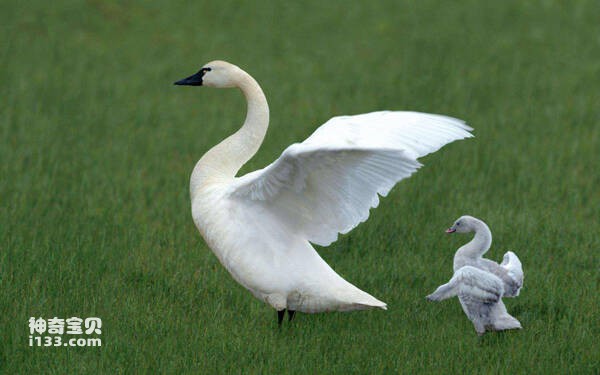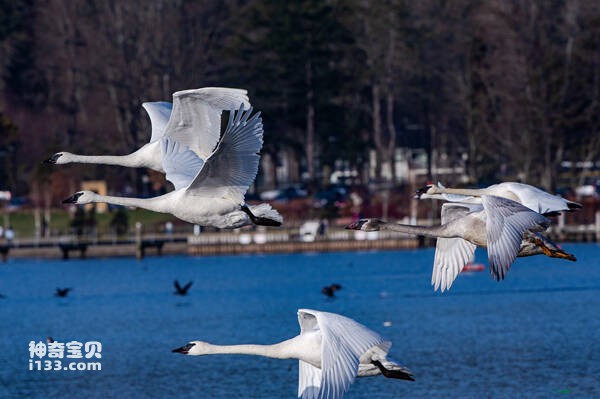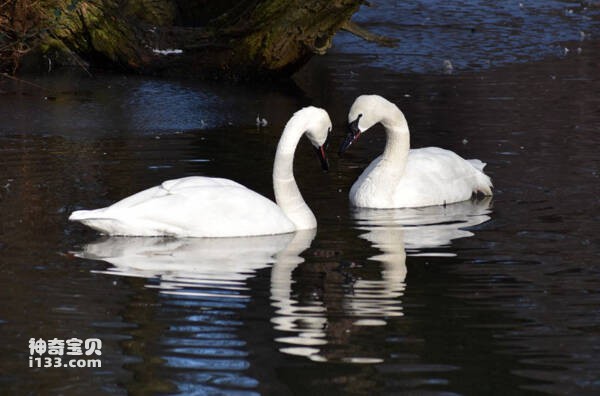Cygnus buccinator
IUCN
LCBasic Information
Scientific classification
- name:Cygnus buccinator
- Scientific Name:Cygnus buccinator,Trumpeter Swan
- Outline:Waterfowl
- Family:
Vital signs
- length:139-163CM
- Weight:7-13.6kg
- lifetime:Around 32 years
Feature
It is the largest native bird in North America, and its weight and shape are the largest waterfowl living on Earth.
Distribution and Habitat
Distributed in Alaska and western Canada, winter into the southern coast of Alaska, British Columbia and northern areas of the United States, there are also some resident birds in the northwest of the United States, mostly from the release of natural flocks.
In the breeding season, they like to inhabit in open and shallow waters rich in food, such as lakes, ponds and slow-flowing rivers rich in aquatic plants, especially in the coniferous forest zone, the most birch forest zone and the plateau lakes and ponds without forests. In winter, they mainly inhabit in large grassy lakes, reservoirs, ponds, rivers, beaches and open farmland.
Appearance
Black-billed swans are large swimming birds, with males ranging from 145 to 163 cm long. Female 139 to 150 cm. The average wingspan is 2.03 m, the average weight is 7-13.6 kg, and the average life span is 32 years. Male and female are of the same color, the female is slightly smaller than the male, the whole body is white, the iris is dark brown, the beak is black, and there is a pink beak line along the base of the beak. The tarsus, webbed and claw are also black. The young are grayish brown, with a dark head and neck, lighter underbody, tail and flight feathers, and a yellow beak. Slender neck, longer than body length or equal to body length; The base of the mouth is high and the front end is flat, the eyes are bare first; The tail is short and round, with 20-24 tail feathers; The webbing is strong, but the hind toes are not webbed.
Details
The black-billed Swan (Cygnus buccinator) is known as Trumpeter Swan and has no subspecies.

Black-billed swans love to cluster, and often live in groups except during the breeding period, especially in winter, often showing family group activities, and sometimes dozens to hundreds of large groups of birds inhabit together. Migration often takes place in small groups or family groups of 6-20 individuals. The flight height is high, the queue is neat, often into a "one" shape, "people" shape and "V" shape. Migration is mostly carried out along lakes, rivers and other water areas, and constantly stops and forages along the way, so the migration lasts a long time.

The black-billed swan feeds mainly on the leaves, stems, seeds, and roots of aquatic plants, such as lotus roots, elaeagnus, and water plants. The mouth has a strong digging ability and can even dig up food buried 0.5 meters below the mud. In winter, they sometimes go to the fields to forage for grain and seedlings. In addition to plant foods, small amounts of animal foods are also eaten, such as mollusks, aquatic insects, and other aquatic invertebrates. They forage mainly in the morning and at dusk. Feeding grounds and habitats are often near or together. If there is no disturbance, it usually does not change places, and the habitat is relatively fixed.

The breeding habitat of black-billed swans is a wide range of large shallow water ponds and slow rivers in northwestern and central North America, with the largest number of breeding black-billed swans found in Alaska. These swans migrate along the Pacific coast of the United States. Migrate in the winter to Canada or the eastern Northwest Territories, southern states, and even as far south as Pagosa, Colorado Springs.
They usually arrive at the breeding grounds in late April to early May. Breeding season May - June. The nest is built on dry ground on the shore of large lakes, ponds and islands, or on large piles of dry reeds in shallow water near the water. The nest is extremely large, consisting mainly of dried reeds, trichothorax, and moss, and is filled with soft stems of hay, moss, feathers, and down feathers plucked from the female's chest and abdomen. The nest is a round cap, the bottom diameter is about 1 meter, the nest height is 0.6-0.8 meters. The female nests alone. Each clutch lays 4-7 eggs, usually 4-5 eggs, mostly in early to mid-May. The eggs are white or slightly yellowish-grey, average 113×73 mm in size and weigh 320 g. The brooding is done by the female alone, while the male keeps watch near the nest. When in danger, the male chirps loudly, and the female immediately covers the eggs with feathers and nest plants and flies away. The female usually leaves the nest for a short time to forage during the incubation period, which is 32 to 37 days. Soon after hatching, the chicks can follow their parents for food. In case of danger, the parents first hide them in the grass, and then fly away on their own until the danger has passed.
Listed on the International Union for Conservation of Nature Red List of Threatened Species (IUCN) for 2020 ver 3.1 - Not Threatened (LC).
Protect wild animals and eliminate wild meat.
Maintaining ecological balance is everyone's responsibility!








